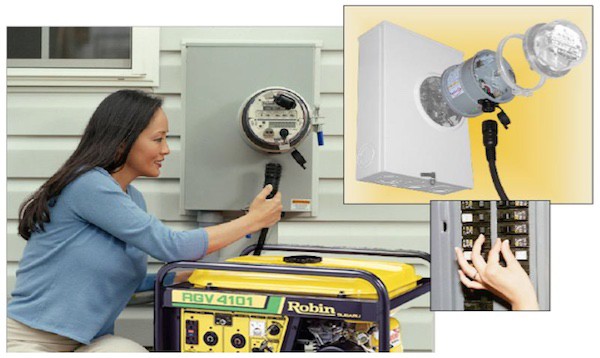Learn how to hook up a generator your house electric panel safely in this video. We run our house with a portable generator and transfer switch when the power goes out, and here we’ll show you how to safely connect a generator to your circuit breaker panel. Watch this video, and read through the text below for more information.
Learn more about installing a generator transfer panel here and how to buy a portable generator here.
AND, watch this video about installing a generator interlock, which is another option for hooking up a generator to your house. It is a simpler option, if an interlock is available for your particular breaker panel.
IMPORTANT:
Do not run a generator in your basement or your garage. Gas engines create carbon monoxide, which will kill you. OK?
This is part of a series of emergency preparedness videos and articles we are writing.
To Hook Up A Generator, The Nuts and Bolts:
Using a portable generator is an affordable way to power the house during a power outage. You can install one of those large generators that sit on cement slab with an automatic transfer switch, but we opted for the less expensive portable generator and a manual transfer switch. I installed the transfer switch myself, but you must follow local electrical codes, and if you are the least bit hesitant, or are not experienced in working on electrical panels, please call a qualified installer.

Before you go off an buy a portable generator, stop, breathe, and do some math. Generators are rated in watts. You need to know how many watts or amps all your electric powered stuff uses.
To determine how many watts of generator power you need, figure out what appliances in the house you want to power with a generator. Each appliance will list on a label somewhere how many watts or amps the appliance uses.
Use the formula if the appliance is rated in amps:
Watts = Volts x Amps
This will help figure out how many watts you need to power your home. And it will give you a good idea of how large a generator you need to buy. Most portable generators are rated by how many watts they generate.
Go around and total up how many watts your fridge uses, the freezer down in the basement, the large TV, the well pump, the sump pump. Think about all the big things that draw power in your house. (Not the Telsa, ok?)
Fridge 750 watts
HDTV 195 watts
Chest Freezer 200 watts
Furnace 400 watts
Microwave ?
Toaster ?
At its most basic, that total wattage number tells you how powerful a generator you need. Keep in mind most of these appliances will not be running all at the same time. Well pumps turn on for maybe a few minutes, furnaces run longer.
Light bulb usage is not worth calculating, I think, especially if you use LED bulbs. The power drawn is minimal.
After 12 years of regular winter power outages, I have found that I never use the full wattage of the generator I bought. If I had to do it again, I would have bought a smaller portable generator. The meters on my transfer panel barely move when powering most of my house. Something to keep in mind.
The only caveat to under sizing a generator is: with my generator, you can tell when the well pump turns on. The generator engine is definitely under load when the water is pumped. Check with your well pump installer for how many amps the well pump needs to run, that is real important. You don’t want to risk burning out your well pump with an undersized generator.
That being said, my friend has a 5k watt generator, and it runs his well pump just fine. But just check how many amps your well pump draws, OK?
If you have a whole house air conditioner, read this post about will a portable generator run whole house AC.
Figure out what circuit breakers control all the things you want to supply power to in a power outage. You will need to buy a manual transfer switch that has that many breakers. Here is one brand I like to use. (affiliate link)
And of course,
A couple of other things I have learned:
If your generator won’t start after sitting for a long time, its time to watch our replace the carburetor video
Listen to me on our podcast, GardenFork Radio, talk about how to hook up generator to a house.
Let us know below your experiences and thoughts on generators and emergency preparedness, how do you prepare for winter storms?










